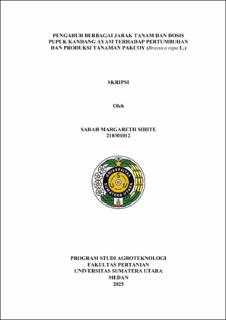Pengaruh Berbagai Jarak Tanam dan Dosis Pupuk Kandang Ayam terhadap Pertumbuhan dan Produksi Tanaman Pakcoy (Brassica rapa L.)
Effect of Various Planting Distances and Doses of Chicken Manure on the Growth and Production of Pakcoy (Brassica rapa L.)

Date
2025Author
Sihite, Sarah Margareth
Advisor(s)
Lahay, Ratna Rosanty
Metadata
Show full item recordAbstract
Pakcoy or Brassica rapa L. is a type of vegetable that is rich in nutrients including protein, carbohydrates, fat, P, Ca, Fe, provitamin A, vitamins B and C, fiber, and various minerals. Proper spacing and dosage of manure can increase nutrient absorption to optimize plant growth and production. This study aims to determine the effect of various planting distances and doses of chicken manure on the growth and production of pakcoy. This research was conducted in Sukajulu Village, Barusjahe Subdistrict, Karo Regency, North Sumatra with an altitude of ± 800 meters above sea level (m above sea level) at coordinates 3°06'46'' East and 98°33'54“” LS, via GPS (Global Positioning System) from February to March 2025. . This study used a Factorial Randomized Complete Block Design consisting of 2 factors with 3 replications. The first factor was planting distance: 40 x 20 cm, 30 x 20 cm, 20 x 20 cm. The second factor is the dose of chicken manure: 0, 4, 8, 12 tons/ha. The results showed that 40 x 20 cm plant spacing significantly produced plant height, number of leaves/plant, stem stalk diameter, total fresh weight/plant, crown fresh weight/plant, selling fresh weight/plant, the highest harvest index and 20 x 20 cm produced the highest root fresh weight/plant, and selling fresh weight/1.6m². Dosing up to 12 tons/ha of chicken manure significantly increased plant height, number of leaves/plant, stem diameter, total fresh weight/plant, crown fresh weight/plant, root fresh weight/plant, selling fresh weight/plant, harvest index, and the highest selling fresh weight/1.6m². The interaction of plant spacing and chicken manure application had a significant effect on plant height 3-4 weeks after planting (WAP) and number of leaves 3-4 weeks after planting (WAP), but had no significant effect on other observed parameters.
Collections
- Undergraduate Theses [3569]
